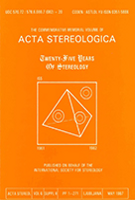A relation between distance maps and radial sampling
Abstract
Radial sampling is a non-homogeneous sampling scheme: a particular point is chosen as the sampling origin and, as the distance from this point increases, data integration becomes coarser and coarser. This scheme has common features with the human visual system and more accurately with the notion of focus of attention. In this way, an image is sampled according to the radial distance from a focusing point. This process can imply the use of distance maps, as we need to define concentric rings centred at the focusing point and supporting sets for data integration. In order to decrease the resolution of the processed images, the rate of information integration must increase with the radial distance. Our study deals with the relation between a sampling process biologically inspired and the classical distance maps.
